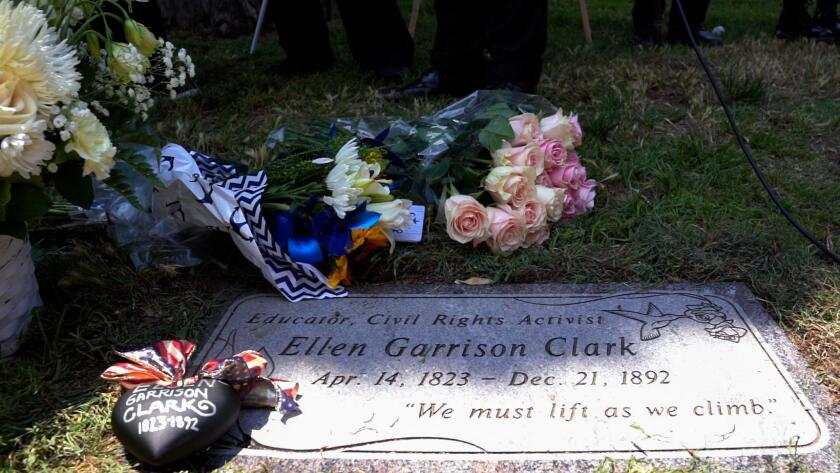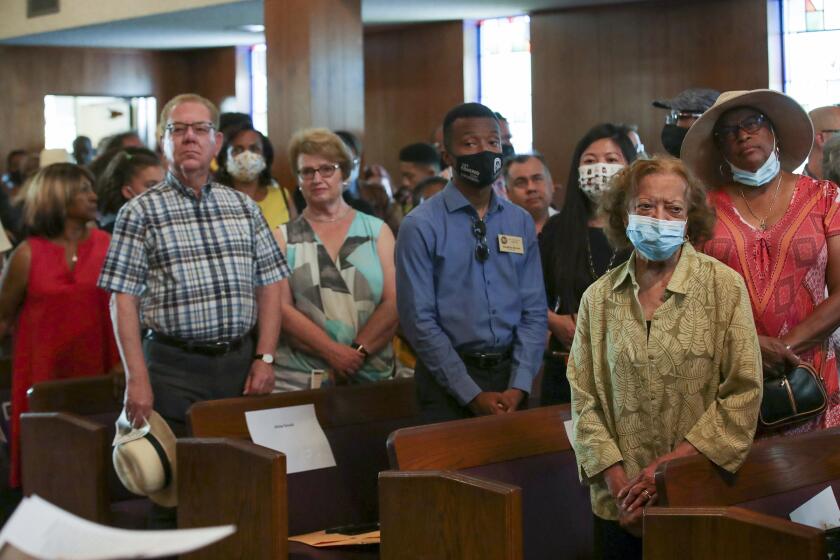She was the Rosa Parks of her day. So why was she in an unmarked grave for 129 years?
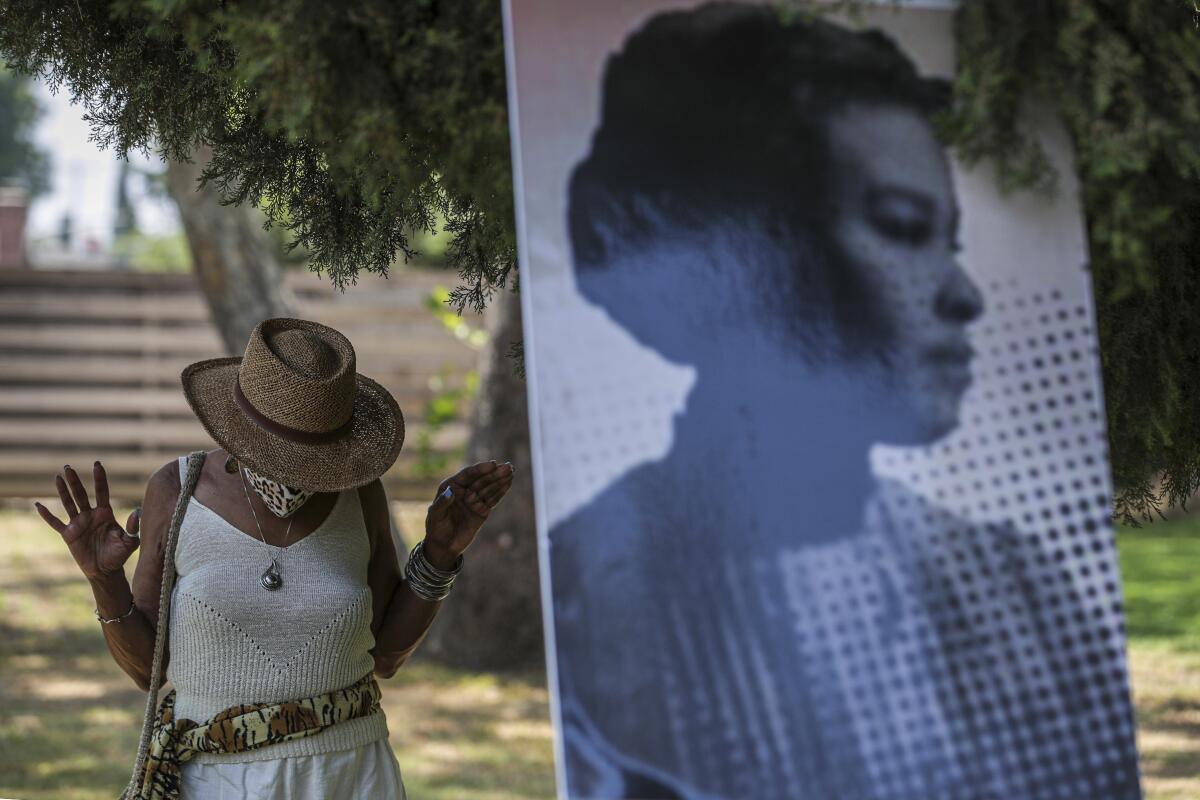
- Share via
For 129 years, Black educator and activist Ellen Garrison Jackson Clark lay unsung and forgotten in an unmarked grave in Altadena’s Mountain View Cemetery.
She was the granddaughter of a freedman who fought in the Revolutionary War and spent years traveling alone through the South to teach formerly enslaved people how to read and write, protected only by a paper “passport” to show she had no owner but herself.
For the record:
3:12 p.m. Aug. 3, 2021Honoring a legend: This story incorrectly states the lineage of Civil War soldier William Gould, who escaped enslavement before fighting for the Union: William Gould IV is the soldier’s great grandson, and Bill Gould is his great-great grandson.
In 1866 she went to court to argue that law-abiding African Americans should be able to sit wherever they chose — nearly 90 years before Rosa Parks refused to move to the back of the bus in Montgomery, Ala.
Few know about her accomplishments — a serious omission, says historian Christina Lenore Davis, “because she was a precursor ... showing us it’s not a new thing for Black women to stand their ground and take the forefront in promoting change.”
Yet until recently, no one knew when or where she had died. Solving the mystery of Clark’s final resting place and marking it with appropriate solemnity took dogged research by historians captivated by her courage, serendipity and the racial reckoning ignited by George Floyd’s murder.
Last month, at a ceremony organized by the Altadena Historical Society on Juneteenth, a granite headstone was unveiled at the long-neglected grave.
- Share via
It was recently revealed that Ellen Garrison Clark was laid to rest in Altadena’s Mountain View Mortuary and Cemetery more than a century ago in an unmarked grave. An anti-slavery activist and educator, she was known for having tested the Civil Rights Act of 1866. The Altadena Historical Society honored Clark, raising $8,000 to purchase a headstone and recognizing her important legacy.
Through speeches and songs, prayers and tears, those gathered remembered the fearless life of a woman who once wrote, “I think it our duty as a people to spend our lives in trying to elevate our own race.”
::
Ellen Garrison was born free in Concord, Mass., in 1823, but her family was well acquainted with bondage.
Historians recognize her maternal grandfather, Caesar Robbins, a patriot who won his freedom by fighting against the British in the American Revolution. Her father, Jack Garrison, escaped his enslavers in New Jersey and ran to Concord, where he lived as a farmer and laborer — and fugitive — the rest of his life.
Her mother, Susan Robbins Garrison, socialized with the abolitionists and transcendentalists who made Concord famous for its liberal leanings, joining Ralph Waldo Emerson’s wife, Lidian, and Henry David Thoreau’s mother, Cynthia, as charter members of the Concord Female Antislavery Society in 1837. She was the only Black member of the group; she hosted its second meeting in her home.
By the time Clark was 15, she signed petitions demanding equal rights for Native Americans and advocating desegregation of Massachusetts trains and Boston schools.
Much of what we know about Clark comes from letters, preserved at the American Missionary Assn. Archives at the Amistad Research Center in New Orleans and the Robbins House-Concord’s African American History, a nonprofit group dedicated to documenting Concord’s African American and anti-slavery history from the 17th to 19th centuries. The group established the Robbins House Museum in the simple 544-square-foot home that once belonged to the Robbins family. Clark lived there as a child.
In 1857 at age 34, Clark married John W. Jackson, a free Black farmer from Delaware. He died a few years later.
She began teaching at a private school in Newport, R.I., but during the Civil War she felt a higher calling — to work with the American Missionary Assn. to teach former slaves to read and write throughout Virginia and Maryland, while stoically enduring the daily indignities of racism.
“I have generally walked through the streets unmolested,” she matter-of-factly wrote in one letter. “It is only occasionally that I have been beaten and stoned in the street.”
Clark also recounted a story of a man who stepped on her dress and complained she was walking too slowly on the sidewalk. He called her the N-word and threatened to slap her on the mouth.
“I told him in a very decided manner he would not do it,” she wrote. “He then passed on. I have found one thing about these people; if they attack you, be careful to stand your ground and they will leave you, but if you run they will follow.”
Her courage “is just so powerful,” said Davis, a professor of Africana studies at Savannah State University in Georgia. “She had this voice and the strength to stand up to racism even in the hostile South.”
That fortitude came to bear a month later, when Clark wrote that she and fellow Black teacher Mary Anderson were “thrown, literally thrown” from the ladies sitting room at the Baltimore train depot.
“This is the first time that I have felt it to be my duty to make any serious complaint, but an outrage has just occurred that demands attention,” Clark wrote in her elegant cursive on May 9, 1866.
“We were injured in our persons as well as our feelings, for it was with no gentle hand,” she wrote, adding, “I feel the effects of it still.”
Clark’s employer in Baltimore encouraged her to pursue a suit. “He wishes to ascertain whether respectable people have rights which are to be respected,” she wrote. “Thus you see it will be a question of much importance. It will not benefit us merely as such ... but it will be a stand for others.”
Clark and Anderson wanted the station master, Adam Smyzer, held accountable, saying he posed as a police officer while he dragged them out of the depot. The suit was meant as a test of the Civil Rights Act passed the month before, said John Hannigan, a historian and curator of the Massachusetts Archives who has researched Clark’s life.
The Civil Rights Act of 1866 made African Americans citizens of the United States, “but it wasn’t clear what that meant,” Hannigan said. “Did it mean that they could access a segregated waiting room, for instance? Ellen wanted to explore how that would work.”
Clark’s legal action made headlines in an era when “respectable” women did not draw attention to themselves — and Clark “was the very definition of respectable,” said Davis.
“I had no idea of the sensation it would create,” Clark wrote on May 21, 1866. “It certainly requires a great degree of moral courage to act in this matter [but] ... I feel it is a good and glorious [effort] in which I am engaged.”
The opponent’s counsel tried unsuccessfully to get Clark and Anderson to settle out of court. “We could not agree to compromise ... unless we can have all our rights conceded to us,” Clark wrote. Then, the station master’s counsel seized the upper hand by requesting a jury trial.
That legal gambit paid off in two ways. “Maryland’s all-white juries would have been unlikely to convict,” said University of Maryland School of Law Professor David Bogen, author of “Precursors of Rosa Parks: Maryland Transportation Cases Between the Civil War and the Beginning of World War I.” It also resulted in Clark and Anderson being sent home to await notice of a future court date.
Although Clark was assured that authorities “promised to notify us whenever we were wanted” for testimony, the case was ultimately dismissed on July 8, 1866. The reason? Clark and Anderson never appeared on the day of trial.
Given Clark’s earlier refusal to settle, the case’s end puzzles historians. Did Clark give up? Was notice of the court date sent to the wrong address? Or was it intentionally withheld to deny Clark and Anderson their day in court?
Researchers don’t have an answer. Clark doesn’t mention the case again in her letters, and news coverage of the trial ceased. When funding for her employer ended around 1870, Clark lost her teaching job. Then she seemed to disappear.
::
Historians have spent decades trying to piece together the lives of early civil rights activists like Clark. In years past the work was daunting, with researchers looking for newspaper obituaries in local libraries or visiting courthouses to decipher faint and spidery handwriting in 19th century ledgers.
But the digitization of records has been a boon to historians, and slowly a fragmented picture of Clark’s life has emerged.
Pennsylvania Quakers hired Clark in the 1870s to work at Black schools in North Carolina. It appears she was held in high esteem because she was either starting new schools or tasked with reviving schools that were flagging.
The work was crucial. It’s estimated that at least 90% of the emancipated people were illiterate, Davis said, largely because it had been illegal to teach slaves to read and write.
“So many people believed that Black people couldn’t learn, and there was a belief that white blood would give them a leg up in their ability to understand,” Davis said. Again and again, when Clark was asked to judge the capacity of her Black students to learn compared with white pupils and other people of color, Clark offered a resolute, one-word answer: “Equal.”
Davis lost track of Clark after her years in North Carolina, but Hannigan used census records and the database FamilySearch.org to pick up her trail in an unexpected place: Barton County, Kan. Clark settled there around 1879 and taught “Exodusters” — nicknamed after the biblical book of Exodus — who were formerly enslaved people looking for land and escape from the increasing racial violence and oppression in the South.
Hannigan also learned that in 1881, at 58, she married Harvey Clark, a Black homesteader and widower from South Carolina.
In 2017, Robbins House co-founder Liz Clayton traveled to Kansas to search archival records. With the help of Great Bend Historical Society member Karen P. Neuforth, she discovered a deed of sale for Harvey Clark’s homestead, dated 1892.
The real find though was text listing his residence as Los Angeles County. Neuforth checked county records for 1892 and discovered that he was registered to vote in Pasadena.
“That was very exciting,” Hannigan recalled. “Aha! The missing link was here.”
A call to the Registrar of Vital Records for the city of Pasadena then revealed that Ellen G. Clark had died Dec. 18, 1892.
But where had she been buried?
Hannigan had discovered an obituary for Clark’s sister, Susan G. Johnson, that said she died in Pasadena in 1897 and was buried in Mountain View Cemetery.
So Hannigan made one more call, and suddenly he had an answer.
“I spoke with the cemetery caretaker and right there on the phone he was able to confirm Ellen G. Clark was buried there,” he said. She had died from consumption — tuberculosis — at 69 and may have come to California hoping for a warm-weather cure as had thousands of others at that time.
“It was exciting, just amazing that something I’d looked for for years — literally years — I was able to find with a phone call in a matter of minutes,” he said.
Hannigan shared his findings with the Robbins House Museum. All were shocked to discover that Clark’s grave didn’t have a headstone. The museum offered to buy a marker, but the cemetery refused: That required permission from next of kin.
But Clark never had children. As far as anyone knew, she had no living family members.
::
The predominantly white and graying members of the Altadena Historical Society knew nothing of the research into Ellen Clark, but they too were looking to uncover long-neglected history in a city about 23% Black.
For years, the society had discussed ways of documenting the entire community’s history — not just the white folks’ — without any action, said Jean Phillips, a steering committee member. Then came the murder of George Floyd in May 2020, and the nationwide wave of Black Lives Matter protests that followed.
“I was just so inspired by the number of the people who were actually moved to do something, and I was very anxious for us to be a part of that positive reaction,” Phillips said. “I come from a marketing background in a big corporation, and it’s like fingers on a chalkboard when I hear these [corporate] statements of support for Black Lives Matter, because I know damn well they aren’t going to live up to it. And I felt, ‘We can’t do this. We have to live our words.’”
So in the fall of 2020, the board voted to act. With each quarterly newsletter, the society would shine a spotlight on the community’s “hidden history” that no one had been eager to acknowledge before, such as redlining — discriminatory lending practices — and covenants, all designed to keep non-Caucasians from buying in certain Altadena neighborhoods. The society also vowed to seek out the oral histories that would document the struggles and triumphs of sidelined members of the community.
The pandemic stalled some of those good intentions. But the society’s new mission took on urgency when board member Jane Brackman got a call this year from her sister Barbara Brackman, a Civil War quilting historian and author based in Kansas.
Barbara Brackman happened to be researching quilters from Concord when she stumbled upon information about Clark, her civil rights activities and the recent discovery of where she died.
“She called me and said, ‘Did you know this Ellen Clark is buried in Altadena?’” Brackman recalled. “And that surprised us. I said, ‘It has to be at Mountain View.’”
The society’s steering committee wanted to buy a headstone for Clark immediately, but Altadena Town Council Vice Chair Veronica Jones, one of the historical society’s few Black members, intervened. She saw an opportunity.
“A lightbulb went off,” Jones said. “My thought was, ‘Let’s get the African American community to pay for her headstone, because she’s African American, and we’re on her shoulders.’ And everything lined up for us to make it happen.”
Jones had another motive: Contributors automatically became members of the society, instantly diversifying their ranks.
By now, the cemetery owner enthusiastically waived its installation fees and the need for authorization from next of kin. VJ Memorials in Chino completed the headstone in less than four weeks — a minor miracle since the pandemic created a huge backlog of headstone orders, said cemetery controller Jim Sickonic. Within a few weeks, $8,300 had poured in to easily pay for the grave marker, ceremony and reception.
“My daughter would say it’s like karma,” Jones said. “It just all came together, like it was meant to be.”
::
Mountain View holds the graves of many notables — author Octavia Butler, activist Eldridge Cleaver, physicist Richard Feynman and actor George Reeves to name a few.
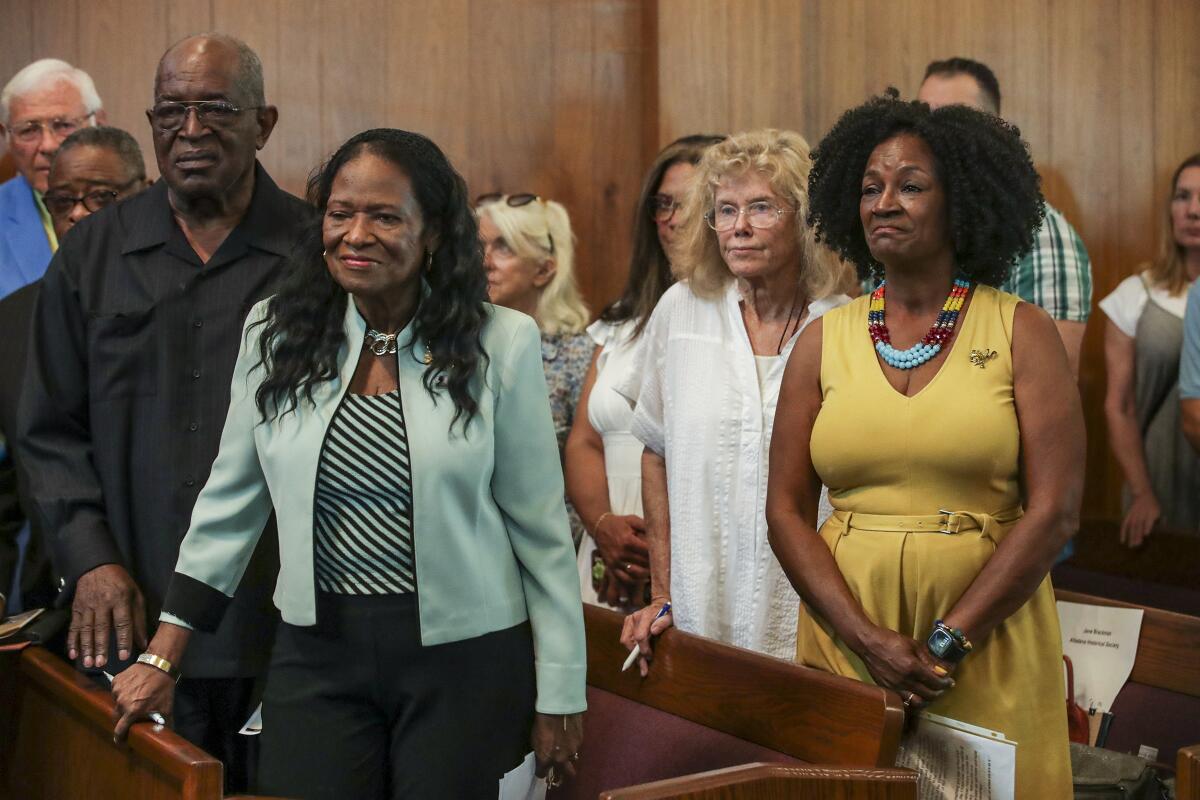
Clark’s celebration of life was held on Juneteenth, the holiday commemorating June 19, 1865, when word of the Emancipation Proclamation belatedly reached Texas. The ceremony brought together a diverse, standing-room-only crowd in the cemetery’s Sunrise Chapel. In Massachusetts, members of the Robbins House Museum watched the ceremony live online.
There was a color guard of three solemn teenagers, one of whom, Alina Gould, is a descendent of an escaped slave whose great-great-grandson, William Gould IV, would become the first Black law professor at Stanford University.
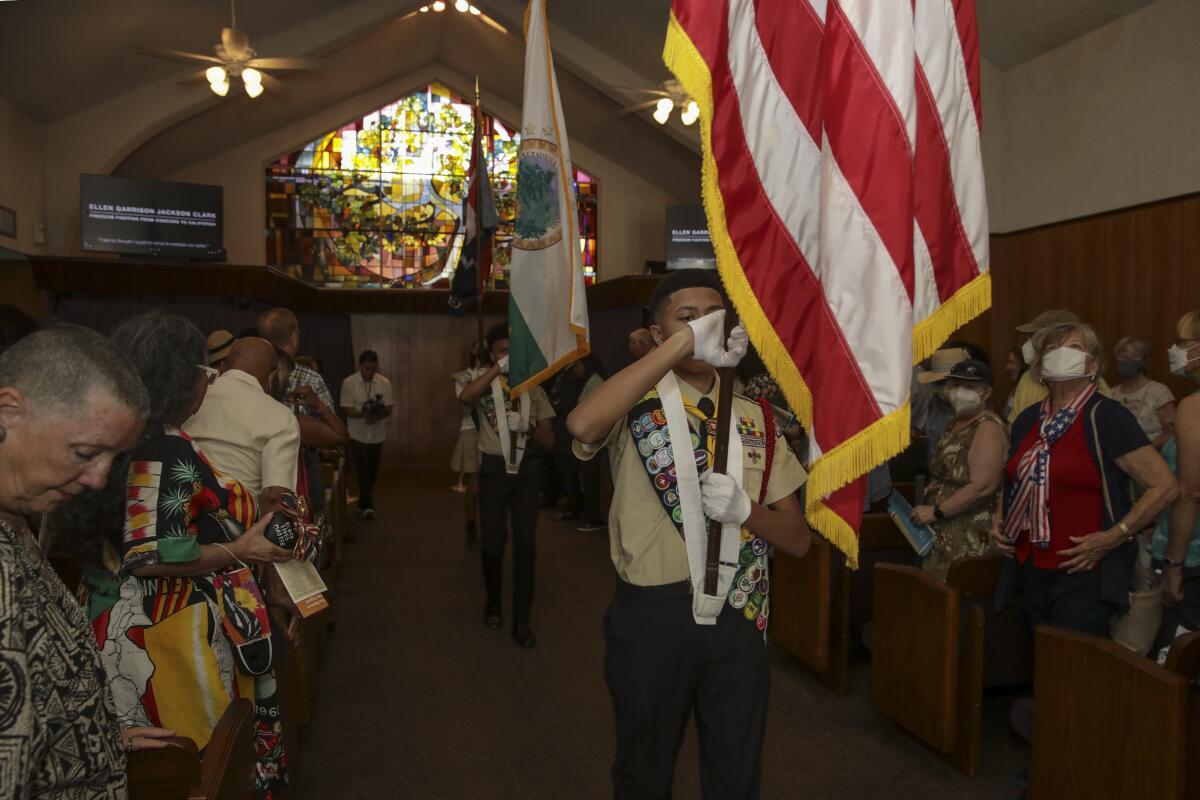
The family knows about Gould’s legacy because of detailed journals he left behind. During the ceremony, Alina’s father, Bill, a lecturer at USC, found himself wondering whether someone like Ellen Clark had taught his great-great-great-grandfather how to read and write.
Then it was time for the simple granite marker to be unveiled: “Educator, Civil Rights Activist Ellen Garrison Clark, Apr 14, 1823 - Dec. 21, 1892.”
The historical society embellished her marker with a small hummingbird — inspired by the Mayan belief that they were messengers for the gods — and a saying that Clark both embodied and embraced:
“We must lift as we climb.”
Sometimes simple calendar items are the introduction to a really good story. Such was the case of teacher and activist Ellen Garrison Jackson Clark and a small notice about the Altadena Historical Society’s Juneteenth celebration of her courageous but little-known life.
More to Read
Sign up for The Wild
We’ll help you find the best places to hike, bike and run, as well as the perfect silent spots for meditation and yoga.
You may occasionally receive promotional content from the Los Angeles Times.
